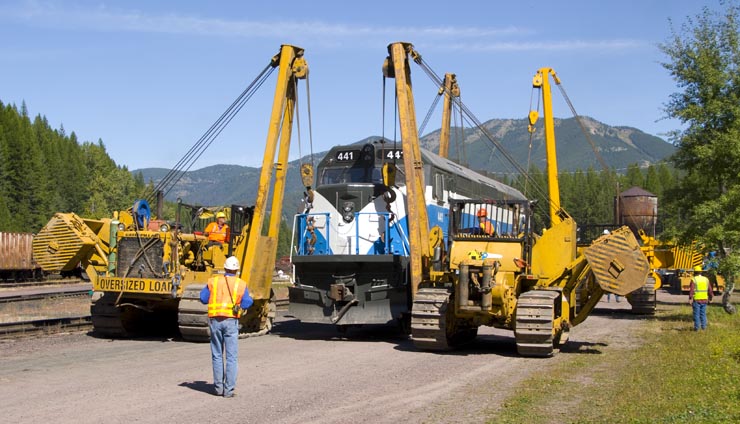Feature writing on technology has taken me to a lot of strange places. One was riding aboard a Hughes 500 with a very skilled crew, working alongside a live high-voltage power line in Pennsylvania. Here's my article:
https://www.airspacemag.com/flight-today/high-tension-1946706/
Here's what these jobs look like:
It was soon clear why this job was so demanding for the pilot. It wasn't just that the helo had to hover a few feet from the line, or that the altitude was so low that an engine failure would have certainly ended in a crash. That's because a safe engine-off auto-rotation is impossible in such a situation.
The biggest risk was the fact that the tail rotor was on the same side of the ship as the power line. A pilot error that brought the tail rotor against the cable would destroy the rotor instantly, putting the ship into a spin followed by a crash.
I spent quite a bit of time on the humble tail rotor's history and purpose in my helicopter book, The God Machine, because the tail rotor may seem like some kind of appendage rather than a crucial, delicate component. It's essential to the most common type of helicopter, the single-main-rotor design, because it counters the powerful torque from the main rotor.
A reminder of how this noisy little device needs a high level of respect comes in a new report from Canada's Transportation Safety Board. The most likely reason that a helicopter carrying a powerline-maintenance crew for Hydro One crashed in Ontario this month, killing all four aboard, was because an unsecured tool bag came loose from the work platform and rammed the tail rotor:
http://www.cbc.ca/news/canada/ottawa/tsb-update-dec-21-fatal-helicopter-crash-1.4460319
Here's a side-by-side from the TSB, tool bag on the left and tail-rotor blade on the right:
So, helo passengers, pay attention to that safety briefing! Even lightweight objects can tangle and destroy a tail rotor, like a jacket flying out a side door.
Thinking about the Amtrak derailment at DuPont, Washington, last week. The latest information suggests the engineer took the train into a very tight curve at much too high a speed. When he did operate the emergency brakes, (allegedly) it was far too late.
https://www.nbcnews.com/news/us-news/amtrak-train-s-crew-noted-high-speed-just-crash-ntsb-n832156
In the first days, before NTSB's initial reports were available, news outlets looking for an angle described the extreme challenge of moving the locomotive that had bulldozed its way onto the interstate, because it was so heavy.
Actually, not that heavy, at 135 tons. The capabilities of derailment contractors, specialized riggers, and heavy haulers are, in a word, awesome. It's just that we don't often see such equipment in the news feeds. In this post I wrote about strand jacks:
http://disaster-wise.blogspot.com/2013/04/strand-jacks-pulling-for-you_24.html
In this post, about how re-railing crews work:
http://disaster-wise.blogspot.com/2010/09/from-derail-to-re-rail.html
A few years ago I asked an engineer at Hulcher, a company specializing in re-railing, the most challenging problem his crews faced: he described a jumble of derailed locomotives at the bottom of a steep valley, where a tall railroad bridge offered the only access. That setting is difficult because wrecking cranes, which have the horsepower to pull about anything, can't spread their stabilizers.
Here's the website of Oxbo Mega Transport, the Oregon company that hauled the engine from the interstate:
http://www.oxboinc.com/
A good local article about the difficulties of a rapid, specialized move:
https://www.thechronicleonline.com/news_paid/columbia-county-company-vital-to-amtrak-crash-cleanup/article_17725cf2-e779-11e7-b4ce-eb20c51ca6bc.html
Here's the rig. Oxbo started with a short but massive trailer used for hauling transformers up to 300 tons in weight, then lengthened and lowered it to allow the load under bridges:
Here's the rig rounding a curve - slowly!
So the job at DuPont was challenging, but no means the biggest for Oxbo. Here's one of the company's bigger jobs - note the many axles in use:
Here's the best image I could find showing the two hydraulic cranes used for the lift.
While this picture doesn't show clearly what the Liebherr in the foreground is picking up, note the stacked counterweights - indicating it's rigged for a long-reach lift, or a heavy load.
A more typical loco-lift involves sideboom tractors working together, like this:
Thinking about the initial puzzlement and pessimism in early reports - "How could anybody clear such a mess in a few days?" - it's not surprising. We live in a consumer-oriented time, with a tight focus on affordable, high-performance gadgets that are car-size or smaller. Spending for passenger rail quality, such as Positive Train Control, is just not entertaining enough.
Meanwhile, the unseen hardware necessary to drive our consumocracy - transport, factories, generators, and mineral recovery - is getting bigger and greatly more complex. So it's not surprising that general-interest reporters are years behind in estimating the capabilities of heavy industry.







